It’s an SUV, Jim, but not as we know it. A closer look at this high-performance beast that doubles as a year-round family hauler.
Aktualizace: 7. listopadu 2023

SUVs now dominate what was once the North American ‘car’ market, and everybody wants in on the act – even exclusive luxury brands like Porsche, Bentley, and Rolls-Royce. Lamborghini comes with the Urus, a coupe-like, 305km/h (190mph) five-seater that’ll perform off-road and on.
The Lamborghini SUV has arrived
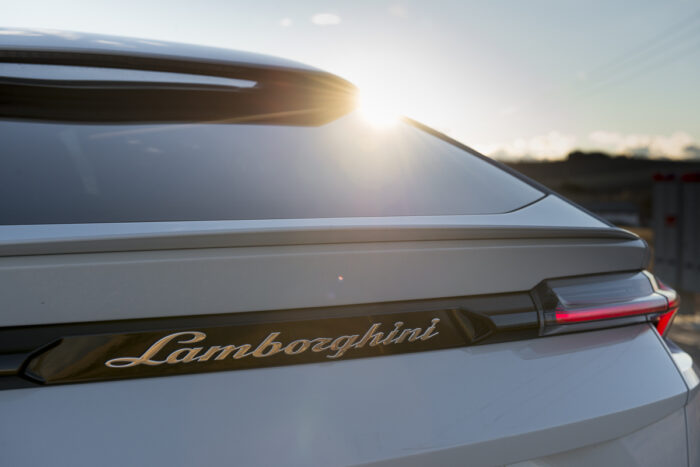
Unlike most of its competitors (a loose term – alternatives to the Urus could include anything from a Porsche Cayenne Turbo S to a top-end Range Rover), Lamborghini has form with what we now call SUVs, having built the rugged LM002 from 1986-93. Urus, however, owes as much to the parent Volkswagen Group as it does to Lamborghini’s history. Its MLB Evo architecture is also used by the Bentayga, Cayenne, and Audi Q7 and Q8.
The Urus is expected to double Lamborghini’s production to around 8,000 cars a year, and about 70% of Urus buyers are expected to be new to the brand. The first deliveries were in late, 2018. As a result, Lamborghini’s overall sales in North America – its largest market – grew by 46% last year. Some 1,095 cars were sold in the US, with a further 316 cars in Canada.
Lamborghini Urus Price
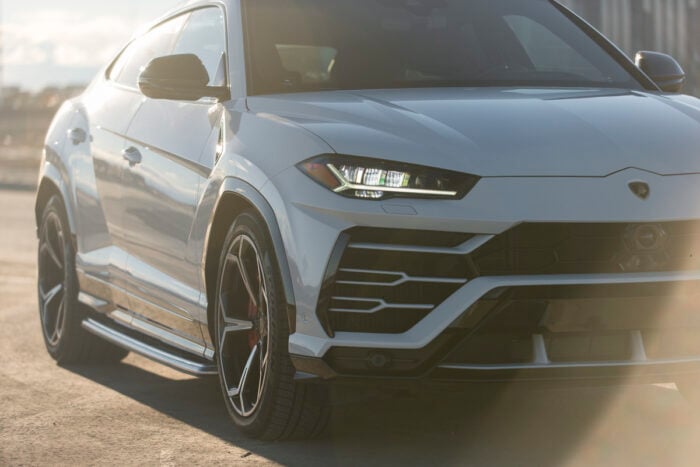
There are no major differences between the US and Canadian-spec Urus, but options can add considerably to the already considerable starting price – C$232,000 or US$200,000. Our test car sported C$45,152 of extras to hit a total of C$277,152.
Aktualizace: The 2024 Lamborghini Urus starts at US$237,848 in the US; In Canada, it’s an approximately C$270,311 MSRP.
Styling: Clean, White Lamborghini Urus for the Win

Styling a Lamborghini SUV must be one of the toughest challenges in car design. The company’s ‘normal’ sports cars stop traffic with uncompromising, angular designs that are all their own, but a family-sized vehicle that must also perform off-road requires a different approach.
The Urus has a sloping front end, coupe-like roofline and copious brand design cues that channel everything from the Countach to the LM002. There’s a two-thirds/one-third metal/glass ratio, Y-shaped front intakes and a hexagonal profile to the wheel arches.
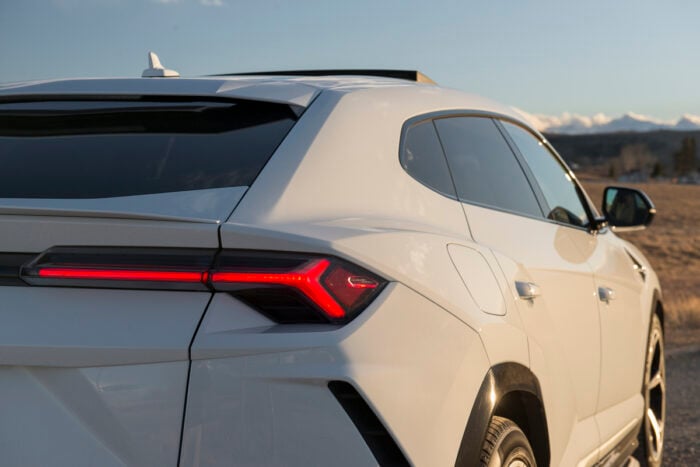
The result is distinctive, certainly, but there are other brands that employ similar shapes and creases – there’s a similarity to some elements of the Lexus RX 450h’s design, for example. Overall, the Urus’s looks are conventional enough that you don’t attract attention from the majority of other road users, which is probably no bad thing for a vehicle of this type, but we also got some enthusiastic waves and thumbs-up from people who knew exactly what it was.
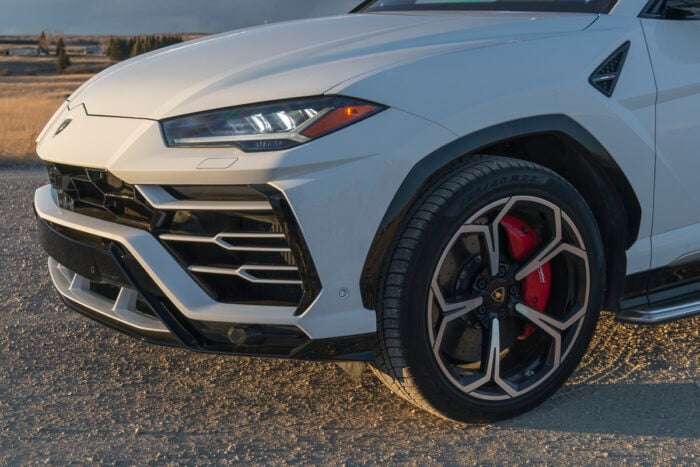
There’s plenty of scope to personalize the look of your Urus. We liked the test car’s combination of Bianco Icarus white paint (no extra cost) with 22in Nath Titanium Matte rims (C$5,817). It also had the Style Package in high-gloss black (C$2,529), a black matte exhaust (C$1,138) and acoustic heat-insulating privacy glass (C$2,782).
Lamborghini Urus Interior
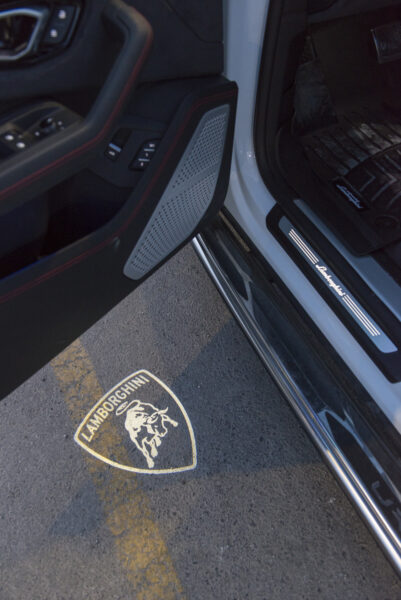
The Lamborghini Urus is accessed using a somewhat unimpressive grey fob, more reminiscent of Audi than Lamborghini. The interior offers easy access, with adjustable seats lower than typical SUV seats but not as snug as sports car bucket seats. The Urus accommodates four occupants, with the rear captain’s chairs slightly reducing cargo space compared to a rear-bench configuration. Despite its coupe-like roofline, there is adequate headroom even for a 6ft 1-inch passenger in the rear seats.
We have a full Urus interior review with a complete gallery here – Inside the Lamborghini Urus: What Does a $200K-plus SUV Interior Look Like?
2019 Lamborghini Urus Engine, Horsepower, and Performance Specs
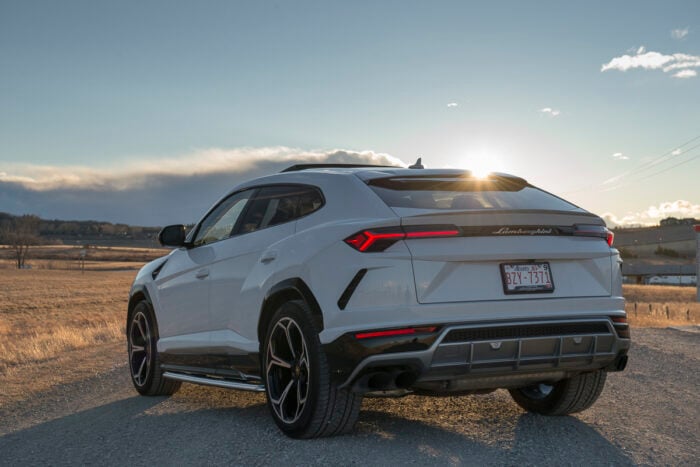
- Motor: 4.0L V8 twin-turbocharged
- Power: 641 horsepower
- točivý moment: 627 lb-ft (850 Nm)
- 0-60h.Akcelerace (0-100 km/h): 3.6 seconds
- Vrchní částRychlost: 190 mph (305 km/h)
- Přenos: 8-speed automatic
- Hnací ústrojí: All-wheel drive (AWD)
- BrzděníVzdálenost (60-0 mph): Approximately 110 feet
The engine is the traditional heart of a Lamborghini. There’s no V12 here, however; instead, the Urus gets a 4L twin-turbo V8 – a modified version of a motor that sees service elsewhere in the Volkswagen Group. It’s mated to an 8-speed ZF automatic transmission.
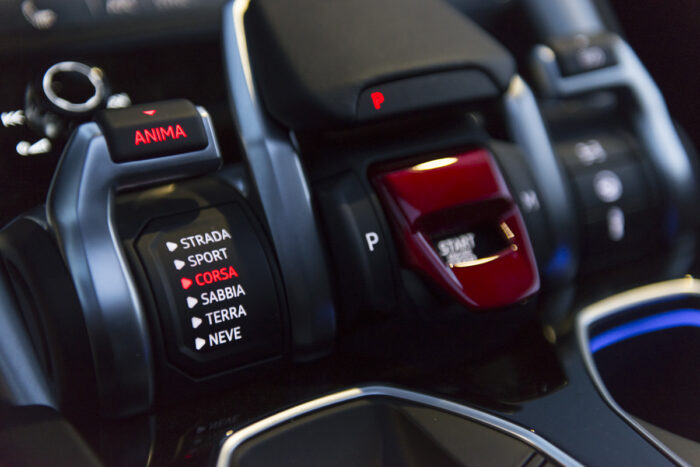
Top Speed of 190 mph (305 km/h)
The V8 makes 641 HP, giving the Urus what Lamborghini claims is the best power-to-weight ratio in its class. It fires the SUV to 100km/h (62mph) in 3.6 seconds and on to 200km/h (124mph) in 12.8, assuming you have somewhere to do it, hitting a top speed of 190 mph or 305 km/h.
Not potent enough? The 2023 Lamborghini Urus S gains more power and an updated design. The improved twin-turbo 4.0L V8 churns out a whopping 666 horsepower and 850 Newton-meters (627 pound-feet) of torque.
The engine’s flexibility – maximum torque of 627 lb-ft arrives at 2,250rpm – gives you the freedom to drive the Urus as quickly or as slowly as you wish. It’s just as happy dawdling around town as it is being hustled along a country road, even in the default Strada (street) drive mode. You won’t hear as much of the engine inside the Urus as those outside will, however – there’s surprisingly little engine noise in the cabin in everyday driving, perhaps too little.
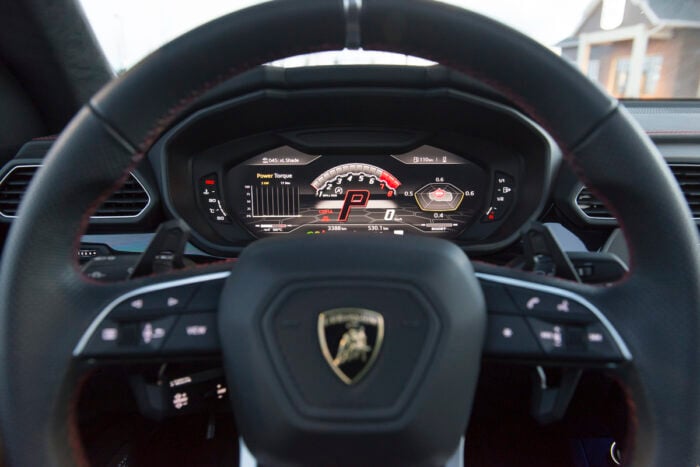
Sport and Corsa (track) modes add more aural drama, as do more revs. The V8 starts to hum from about 2,500rpm and is really singing by 5,000rpm (redline is 6,800rpm). On the right road, it’s an addictive noise, and the exhaust offers up some entertaining pop and crackle on the overrun.
We’re not sure whether anyone cares about the fuel consumption, but for the record, we got 16L/100km (14.7mpg) in mostly non-highway driving. The official combined figure is 13.6L/100km (17.3mpg), but the highway figure is a respectable 9.7L/100km (24.2mpg).
Urus Driving Impressions: A Family SUV That’s Easy to Drive Year Round
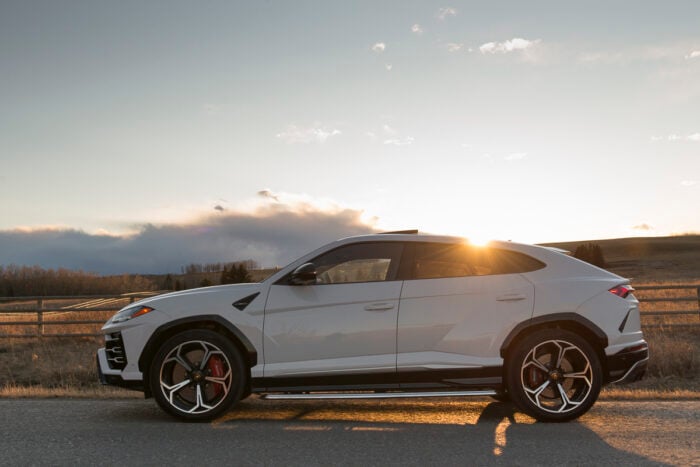
With all that performance on tap, driving the Urus can be very different from being behind the wheel of a mass-market, family SUV. But it’s to its credit that it’s extremely easy to drive in everyday use. For example, the steering is super-light when maneuvering and the four-wheel steering setup helps to make the 5.1m/almost 17ft SUV feel smaller than it really is. That’s essential if Lamborghini is to attract new buyers to the brand, including diversifying its typically male-dominated customer base.
The Urus comes with air suspension, electronically switchable anti-roll bars and adaptive damping. That sophistication results in a surprisingly quiet and supple low-speed ride. We played with the Ego settings to assess the difference in ride comfort at speed, but struggled to make noticeable changes.
The Urus is predictably noisy and fast when you want it to be, but unexpectedly quiet, refined and easy to operate, with one or two reservations, in the everyday conditions in which most will be driven.
What stood out instead was the tire roar from our test car’s Pirelli Scorpion winter rubber – a rare NVH (noise, vibration, and harshness) black spot for the Urus. We weren’t able to check whether it was any better on the standard summer P Zeroes; note that winter tires are not an option on the largest, 23-inch rims.
Roll control is terrific, and the Urus belies its weight and size when you start to throw it around. We’d have loved to see what it could do on track; ‘performance SUV’ is a term applied to all sorts of vehicles that don’t deserve it, but the Urus isn’t one of those.
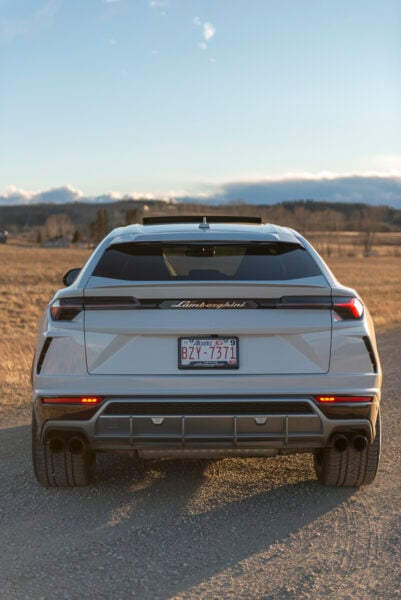
Our only reservation was that, although the steering is accurate and well-weighted at speed, we were missing that last degree of connection to the road. There’s not the on-centre feel we’d have hoped for on the highway and you don’t get much feedback on what the front wheels are doing, but that’s perhaps no surprise given the multiple layers of electronic wizardry separating the steering wheel from the tire.
This is also a driver’s car that will drive itself, sort of, thanks to some well-sorted driver-assistance systems that will guide you down well-marked roads with minimal input. Meanwhile the huge carbon-ceramic brakes – claimed to be the biggest of any production car – will get you stopped no matter what. They also hiss a little at urban speeds, however.
Lamborghini SUV towing capacity
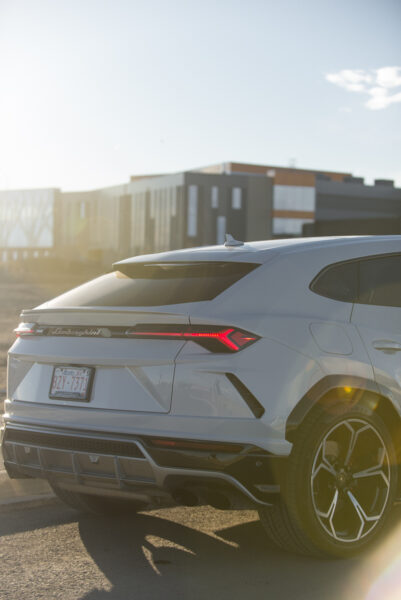
We didn’t have the opportunity to take the Urus off-road, but have no doubt that its complex 4WD system – which includes a central, self-locking Torsen differential and active torque vectoring – will keep you mobile.
The Neve (snow) drive mode comes as standard, but our Urus also had the optional off-road modes and trailer towing preparation (C$886), which adds Sabbia (sand) and Terra (off-road) to the left-hand Tamburo. The Urus will tow 3,500kg (7,716 lb) – enough to haul a sports car on a trailer.
Odnést

Klady:
- Supercar pace, handling
- Docility and practicality in everyday driving
- Exkluzivita
Nevýhody:
- Ergonomically flawed gear selection
- Lack of road feel
- Contrived design cues
This is a longer-than-average review, but there’s a lot to say. That’s a good thing, because if the Lamborghini Urus were just another car, or if it didn’t provoke opinions, it’d have no purpose.
There’s a school of thought that the words ‘performance’ and ‘SUV’ don’t belong in the same sentence, let alone the words ‘super sport utility vehicle,’ which is how Lamborghini describes its vehicle. I can see why some car enthusiasts would feel that way, but it’s not a view I share. If the success of the Urus enables Lamborghini to continue to create the exotic sports cars that just about everybody loves – as the Cayenne has done for Porsche – then that’s fine by me.
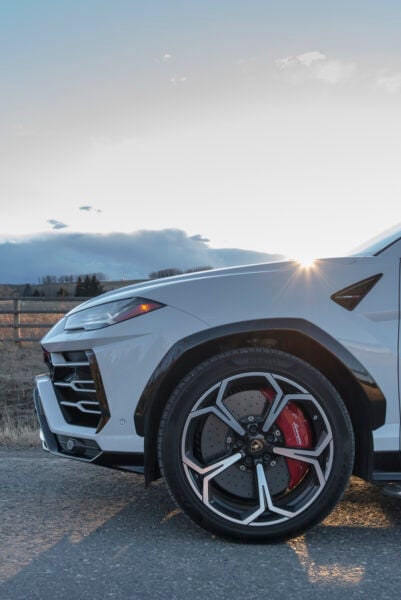
To summarize, then, the Urus is predictably noisy and fast when you want it to be but unexpectedly quiet, refined, and easy to operate, with one or two reservations, in the everyday conditions in which most will be driven.
Lamborghini drivers now have a vehicle that they can use year-round, pretty much wherever they live, thanks to 4WD, the ability to tow, and the flexibility to carry people and cargo. With annual production set to be capped, Urus buyers are also guaranteed something far more exclusive than a Cayenne or a Range Rover, and perhaps with better residual values, too.
Lamborghini Urus Photos and Specs
| specifikace | Measurement/Description |
|---|---|
| Motor | 4.0L V8 twin-turbocharged |
| Koňská síla | 641 horsepower (650 PS) |
| točivý moment | 627 lb-ft (850 Nm) |
| 0-60 mph (0-100 km/h) Acceleration | 3.6 sekund |
| Nejvyšší Rychlost | 190 km / h |
| Přenos | 8stupňová automatická |
| Hnací ústrojí | Pohon všech kol (AWD) |
| Suspenze | Adaptivní vzduchové odpružení |
| Řízení | Elektrický posilovač řízení |
| Brzdový systém | Karbon-keramické brzdy |
| Velikost kola | 21 inches (standard), 22 inches (optional) |
| Pneumatiky | Pirelli P Zero (standard), other options available |
| Pohotovostní hmotnost | Přibližně 4,850 liber (2,200 kg) |
| Délka | 201.3 palce (5,113 mm) |
| Šířka | 79.4 palce (2,014 mm) |
| Výška | 64.5 palce (1,640 mm) |
| Rozvor | 118.2 palce (3,000 mm) |
| Světlá výška | Nastavitelné vzduchové odpružení |
| Nákladový prostor | Approximately 21.8 cubic feet (616 liters) |
| Kapacita palivové nádrže | 22.5 galonů (85 litrů) |
| Fuel Economy (Combined) | Approximately 14 miles per gallon (mpg) |
Even with over $70K in options, I wish the Urus were more exciting.
Daniel Golson Bývalý redaktor sociálních sítí
22. června 2021 2:00 PT
4 min čtení
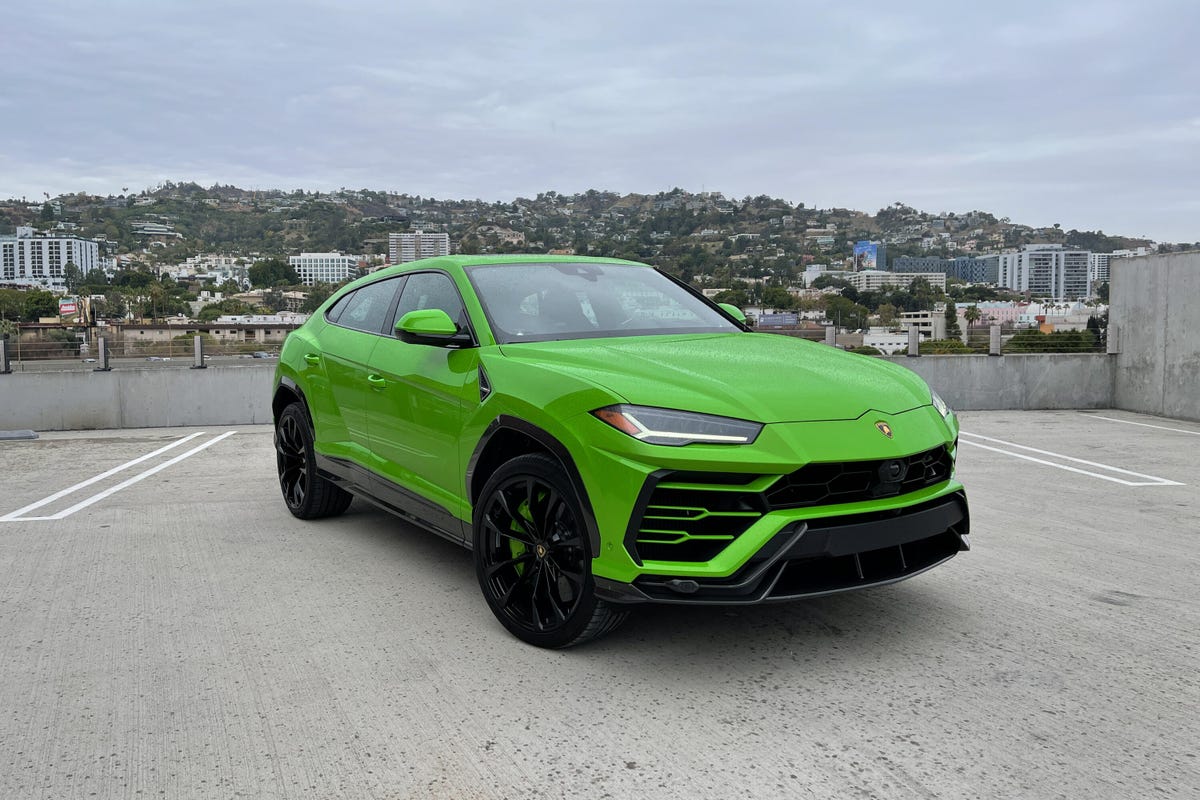
I have no shame in admitting that I’m a big fan of super sporty SUVs . I love the dichotomy created by taking a practicality focused body style that’s traditionally meant for off-roading and giving it wild on-road performance, especially when the SUV in question is coming from a brand that’s typically known for making sports cars. So I was obviously stoked when Lamborghini launched the Urus crossover in 2017, its first mainstream four-door ever. After spending a few days with a Urus, there’s no doubt in my mind that it’s a fantastic SUV. I just wish it were more exciting.

Lamborghini Urus z roku 2021
Like
- Extroverted styling
- Fantastic V8 engine
- Good in-car tech
Nelíbí se
- Too sedate to drive
- Boring interior design
- Way more expensive than the competition
Updates to the Urus for 2021 are fairly minor. There are more shades in the color palette, and there’s a special Pearl Capsule Collection edition that features super-bright hues inside and out. The Urus also comes standard with previously optional driver-assist features like adaptive cruise control, blind-spot monitoring and a head-up display, and the available parking assist package has been upgraded to include automatic parallel and perpendicular parking systems. There’s a new key design, too.
The 2021 Lamborghini Urus stands out even on a gloomy day
I love how the Urus looks — which is a controversial take among my colleagues. It’s not necessarily pretty or attractive, but neither are so many of my favorite Lambos. I think the Urus’ styling looks better the more absurd the spec — in silver or black, it blends in too well with other crossovers — so luckily my tester is finished in a searing shade of pearlescent Verde Mantis paint.
Adding to the visual impact, my Urus test car has $73,747 in options, almost all of which are solely cosmetic upgrades. That green paint costs $9,344, and it’s got a $3,157 protection film. The carbon-fiber finish on the lower parts of the bumpers and side skirts is $14,326, but that package doesn’t include the carbon wheel arches, which are $6,692, or the carbon rear spoiler, which is $1,478. The gloss-black 23-inch wheels cost $5,358, while the matching green brake calipers are $1,262. Rounding out the visual options are $884 matte black exhaust tips and a $2,848 panoramic sunroof.
This Urus’ interior isn’t nearly as extroverted as the exterior, with black leather covering almost every surface. Aside from some design flourishes like lots of hexagonal shapes and angular trim pieces, the Urus’ interior looks pretty boring, but everything is high quality and all the touchpoints feel nice. There’s $2,103 worth of matching lime green stitching and embroidered headrests, though, as well as $6,100 in carbon-fiber trim and kickplates. This Urus also has the $3,157 comfort front seat option that adds 18-way adjustments and ventilation and massage functions, as well as a bangin’ $6,313 3D sound system.
The Urus uses a reskinned version of Audi’s great dual-screen MMI system and a version of Audi’s Virtual Cockpit digital gauge cluster, but the super strange central gear selector and the two drive-mode toggles flanking it are all Lambo. Visibility is a lot better than I was expecting despite the Urus’ slim greenhouse, and there’s a good amount of back seat room. This Urus has the $3,788 four-seat configuration, which adds a fixed rear center console and gives the rear seats 8-way electric adjustment, but the seat backs can still be folded down.
My biggest problem with the Urus is that it doesn’t feel exciting enough to drive. Don’t get me wrong, the Urus is awesome when you get it on a good road. It’s powered by a twin-turbo 4.0-liter V8 engine putting out 641 horsepower and 627 pound-feet of torque, a motor shared with other Volkswagen Group products. It’s absurdly quick, with Lamborghini quoting a 3.6-second 0-to-60-mph time, and the 8-speed automatic transmission rips off quick shifts. It’s super planted in corners with tons of grip from those 23-inch Pirelli P Zero tires, and the torque-vectoring all-wheel-drive system and rear-axle steering make it feel more nimble than its nearly 5,000-pound weight would suggest. The massive 17-inch brake rotors provide excellent stopping power, too.
Around town or on the highway is a different story, though. In the calmest Strada drive mode the Urus is comfortable and quiet — you have no idea how much power is at your disposal. Sport mode takes things up a couple notches, but the engine response and exhaust note are still a little too calm for what I want from a car with a raging bull on the hood.
In Corsa mode the exhaust really wakes up, getting loud and rowdy with constant pops, bangs and crackles when I shift or let off the gas. But the jerkiness and high-strung nature of the engine and transmission in Corsa makes the Urus almost undriveable and annoying if you aren’t going fast. With the Ego switch you can create a personalized drive mode setup, individually toggling through the settings for the drivetrain, steering and suspension. But because the exhaust sound is tied to the drive mode — there’s no switch to make it loud or quiet separate of mode — being in Corsa is the only way to make the Urus sound its best. What the Urus needs is a better middle ground: A sporty drive mode that sounds awesome and feels dramatic without being too much for the street.
The 2021 Urus starts at $222,004 (including a $3,995 destination charge), and my test car rings in at $295,751. That’s a whole lot pricier than the $179,986 Aston Martin DBX , which I think is more special to drive while looking just as exotic. Then there’s the Audi RS Q8 with which the Urus shares its powertrain, chassis and much of its tech and performance features. At $115,595 the Audi is more than $100K cheaper than the Lamborghini, and it’s just as good to drive.
There’s good news on the horizon, though. Lamborghini is working on a facelift for the Urus, which could be called the Urus Evo and pack even more power and enhanced dynamics, and there’s also a plug-in hybrid version on the way. Here’s hoping these new variants inject a little more absurdity into this surprisingly sedate SUV.
















